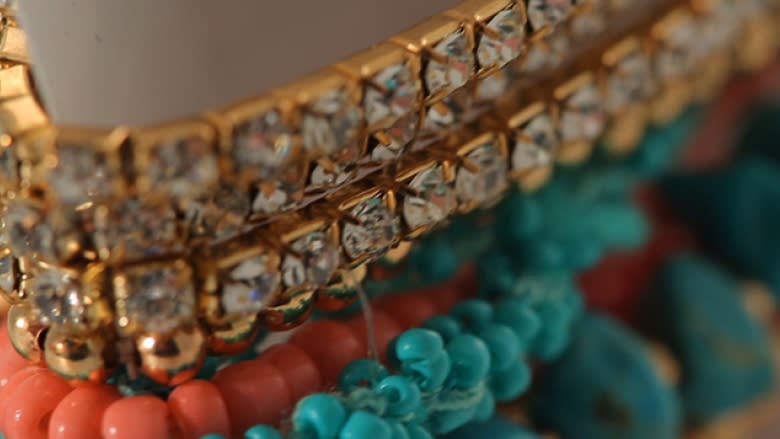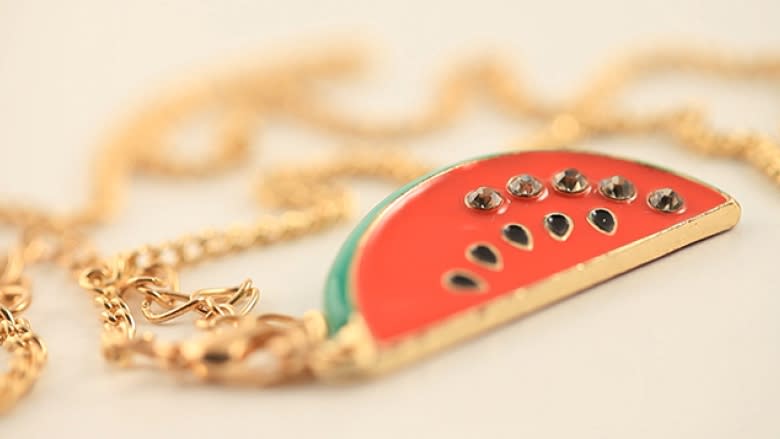Toxic jewelry: Cadmium found in Ardene, Aldo products
Canadians who buy low-cost jewelry from popular fashion chains may be wearing products made with cadmium, a heavy metal that can be particularly toxic for kids.
A CBC Marketplace investigation reveals some Ardene and Aldo Accessories jewelry manufactured in China contains thousands of times more cadmium than Health Canada says is safe for children.
Health Canada considers cadmium to pose a threat similar to lead if ingested.
Cadmium is a known carcinogen, which can lead to kidney failure, bone loss and other complications in those who are chronically exposed over time.
There are no known risks for people who wear contaminated jewelry. Rather, swallowing or chewing on a piece of jewelry containing high concentrations of the toxic metal could allow it to seep into the body.
"Any major system in your body can be harmed by cadmium," says James Van Loon, director of risk management at Health Canada's consumer product safety branch.
Children's bodies more readily absorb the toxic metal and, since they are more likely to put things in their mouths, Van Loon says jewelry that is marketed to those under 15 should contain virtually no cadmium.
Pendant 'close to pure cadmium'
Marketplace sent a group of 12-year-old girls to choose jewelry pieces that appealed to them, since cadmium is considered especially unsafe for children. Marketplace also selected other pieces to test.
In total, Marketplace tested more than 50 pieces of costume jewelry, including necklaces, earrings and bracelets, from various retailers.
Researchers from University of Toronto and École Polytechnique de Montréal tested the jewelry and found seven items from Ardene and Aldo Accessories contained between 15 and 7,000 times the Health Canada threshold for cadmium in children's jewelry.
A shiny blue metal pendant on one Ardene necklace was nearly 100 per cent cadmium. The products Marketplace tested did not list the materials used in the jewelry.
"The results were astonishing," says Dr. Gérald Zagury, who performed the tests and has published several studies on heavy metals in jewelry.
He says it was the highest cadmium amount ever reported in Canada for such a product.
"It's pretty close to pure cadmium," he says.
The six other items also contained high concentrations of the heavy metal.
At 79 per cent cadmium, a decorative charm on a beaded Aldo bracelet contained more than 6,000 times the Health Canada threshold for children's jewelry.
Zagury tested the charm to see what would happen if a small child swallowed it. The results showed that a child's body would absorb unsafe amounts of the metal.
Zagury says chewing on contaminated jewelry could also pose a health risk for kids.
"I would not allow my daughter, for example, to put such a sample in her mouth, even if it's not swallowed," he says. Zagury's daughter is 7.
Aldo to remove contaminated products
Aldo and Ardene declined to speak with Marketplace on camera about the results.
In an email, an Aldo spokesperson said it would remove the items Marketplace identified from store shelves.
"We are committed to increasing our monitoring efforts, and we will work with our vendors to enforce compliance with our internal guidelines," a spokesperson wrote.
Ardene agreed to further investigate the four products identified by Marketplace, though the company says the jewelry wasn't meant for children.
The company also stated that it hasn't received "any customer reports of incidents related to cadmium."
Marketplace also shared the test results with Health Canada.
In response, Van Loon says Health Canada sent inspectors to speak with Ardene and Aldo about the products Marketplace identified in order to "figure out to what extent these may actually be marketed straight to kids."
Van Loon says it's up to parents to make sure kids don't have access to jewelry intended for adults.
Though Canada's policy on cadmium in kids' jewelry remains a guideline, Health Canada can compel companies to stop selling a product if it poses a risk to human health.
In the past, Health Canada has recalled children's jewelry products containing high amounts of cadmium.
Ardene has been the subject of five voluntary Health Canada recalls since 2007 for selling products containing high concentrations of cadmium or lead.
Cadmium: the new lead
None of the products Marketplace tested contained unsafe amounts of lead.
Marketplace first investigated lead in children's jewelry in 2001, and found a troubling lack of rules preventing companies from using the metal. Since then, lead has become more strictly regulated in Canada and elsewhere.
Lead can build up in the body and affect the nervous system, and can lead to learning and behavioural problems in children.
According to Health Canada, some makers of low-cost jewelry may have turned to cadmium as a cheap alternative to lead, once the regulations took hold.
Cadmium is cheap and melts at a lower point than commonly used zinc, making it appealing to jewelry manufacturers because it lowers energy costs.
In recent years, the European Commission has banned cadmium in all jewelry sold in Europe.
Similar rules exist in China, where most costume jewelry is made. Despite this, when Marketplace went to China in December, it found it is relatively easy to find jewelry made with the metal.
Canada's rules are less strict and only restrict the metal in products marketed to children.
"We are focused on the stuff that's targeted at the young kids," Van Loon says.
"In the particular case of low-cost jewelry," says Van Loon, "I think maybe some caution is required."
Health Canada says there have been no reported cases of people getting sick from swallowing cadmium jewelry.






